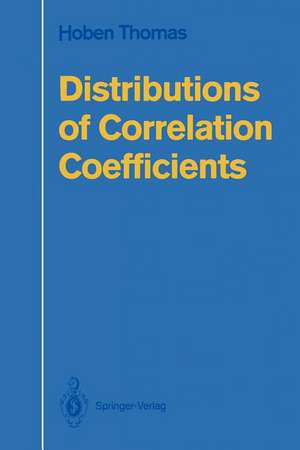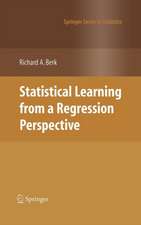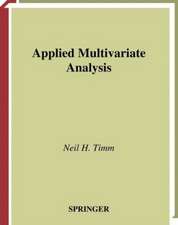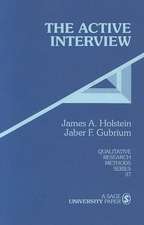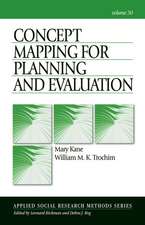Distributions of Correlation Coefficients
Autor Hoben Thomasen Limba Engleză Paperback – 18 apr 1989
Preț: 631.21 lei
Preț vechi: 742.60 lei
-15% Nou
Puncte Express: 947
Preț estimativ în valută:
120.80€ • 131.17$ • 101.47£
120.80€ • 131.17$ • 101.47£
Carte tipărită la comandă
Livrare economică 23 aprilie-07 mai
Preluare comenzi: 021 569.72.76
Specificații
ISBN-13: 9780387968636
ISBN-10: 0387968636
Pagini: 95
Ilustrații: X, 95 p.
Dimensiuni: 155 x 235 x 6 mm
Greutate: 0.16 kg
Ediția:Softcover reprint of the original 1st ed. 1989
Editura: Springer
Colecția Springer
Locul publicării:New York, NY, United States
ISBN-10: 0387968636
Pagini: 95
Ilustrații: X, 95 p.
Dimensiuni: 155 x 235 x 6 mm
Greutate: 0.16 kg
Ediția:Softcover reprint of the original 1st ed. 1989
Editura: Springer
Colecția Springer
Locul publicării:New York, NY, United States
Public țintă
ResearchCuprins
1. Introduction.- 1.1 Motivation and Background.- 1.2 Conceptual Problems of Validity Generalization.- 1.3 An Alternative Formulation.- 2. A Validity Generalization Model.- 2.1 Introduction.- 2.2 Classical Test Theory.- 2.3 A Validity Generalization Random Model.- 2.4 The Joint Space of P and E.- 2.5 P and E Are Dependent Variables.- 2.6 The Distribution of R, c(r).- 2.7 Are P and E Correlated?.- 2.8 Identifiability.- 3. Estimation.- 3.1 Introduction.- 3.2 Lehmann’s Classification.- 3.3 Sample Data.- 3.4 The Basic Sample Estimates.- 3.5 The Estimator SP2 = SR2 ? S*2.- 3.6 Interpreting Estimators.- 3.7 The Expectation of SR2.- 3.8 The Expectation of S*2.- 3.9 The Expectation of SP2.- 3.10 Numerical Evaluation of ?(SP2).- 3.11 The Distribution of Sp and the Power Problem.- 3.12 The Consistency of SP2.- 3.13 The Limiting Behavior of SR2.- 3.14 Multifactor Estimation Procedures.- 3.15 A Representative Multifactor Estimator.- 3.16 A Comment on Z Transformations.- 4. Summary and Discussion of Validity Generalization.- 4.1 Summary of Model Properties.- 4.2 Validity Generalization and Classical Test Theory.- 4.3 Summary of Estimation Procedures.- 4.4 Consistency and Identifiability.- 4.5 The Bayesian Connection.- 4.6 Computer Simulation Studies.- 5. A Conditional Mixture Model for Correlation Coefficients.- 5.1 Introduction.- 5.2 Finite Mixture Distributions.- 5.3 A Modeling Distribution for R.- 5.4 A Mixture Model Distribution for R.- 5.5 A Parent Distribution for Histograms of R.- 5.6 Comment.- 6. Parameter Estimation.- 6.1 Introduction.- 6.2 Estimation Equations.- 7. Examples and Applications.- 7.1 Introduction.- 7.2 Artificial Data, Example 1.- 7.3 How Many Components in the Mixture?.- 7.4 Electrical Workers, Example 2.- 7.5 Army Jobs, Example 3.- 7.6 Army Jobs,Example 4.- 7.7 College Grades, Example 5.- 7.8 Law School Test Scores and Grades, Example 6.- 8. Artifact Corrections and Model Assumptions.- 8.1 Artifact Corrections.- 8.2 Identifiability of Mixtures.- 8.3 Failure of Model Assumptions.- 8.4 Properties of the Maximum Likelihood Estimates.- 8.5 Miscellaneous Comments.- Notes.- References.- Author Index.
